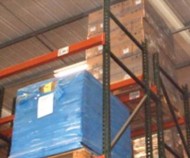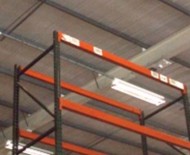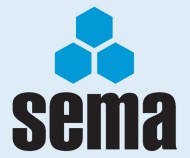 Our first query this month Is looking for clarification on missing pins and securing column guards and our second looks at what guidelines should be followed to gain accreditation.
Our first query this month Is looking for clarification on missing pins and securing column guards and our second looks at what guidelines should be followed to gain accreditation.
A Alteration to Racking design
Q. Can you look at the attached images and let me know if we are ok to change the racking as per image 2?
We are not sure if this is allowed as there is no overhang at the top with the side supports, my concern was that if we load onto that level that pallets could fall off sideways.
A. The straightforward answer to your query is that there is nothing in the SEMA or any other UK code of practice that prohibits using a beam such that the top storage level is continuous over the uprights as you show in your photograph. In saying this of course it is necessary to have a ‘top welded’ beam (i.e. a beam that has the top bearing surface within a few millimetres of the top of the connector that hooks into the upright). All connectors do need to hook into pockets in the upright in the correct manner. It would seem from the photographs that they are fulfilling this requirement however this is not always the case with all beam types.
There is a case for suggesting that a higher end frame should be provided at the end of a run of racking as you suggest to provide an additional level of safety in case goods fall off a pallet into a transverse gangway. In the UK this would come down to the specific risk assessment that you would need to carry out in your warehouse looking at the particular risks of the operation. For instance if you had a lot of traffic in this transverse gangway, including perhaps a number of pedestrian order pickers then you might well decide that this risk needed to be dealt with however if it was a ‘trucks only’ operation then the risk would be fairly minimal.
We would remark that the risk in our opinion is more likely to be individual packs of goods falling off a pallet in this situation rather than a whole pallet falling. If the pallet is correctly placed by a competent operator the pallet itself should not be in any danger of falling. If for instance the goods were shrink wrapped then this risk would also be substantially reduced which I am afraid brings us back to the specific risk assessment for your particular operation.
Many years ago in the Pas de Calais region of Northern France they had an accident involving goods falling not into the aisle itself but in the transverse gangway and this resulted in a ‘local’ regulation requiring frames at either end of runs of warehouse racking in that area to be something of the order of 900mm higher than the remainder of the frames in that run. We do not believe this was ever converted into a French national regulation and are certainly not aware of any similar requirement in the UK though as we have said this risk would in the UK be considered as part of the overall warehouse operational risk assessment.
If you do decide that for your particular operation you need these frames at the ends of runs to be taller most suppliers of racking will provide a bolted splice frame extension which would allow the frame to be increased in height without the need to change the complete frame. The position of the splice might then prevent you from locating a beam at a particular height however this varies between rack manufacturers.
OHSAS 18001,What guidelines do we need?
 Q. We are in the process of undergoing the accreditation process for OHSAS 18001. During this process storage racking was discussed and I believe that SEMA has guidelines available concerning the inspection, control and care of racking? If so could you please let me know how I may obtain a copy of these guidelines?
Q. We are in the process of undergoing the accreditation process for OHSAS 18001. During this process storage racking was discussed and I believe that SEMA has guidelines available concerning the inspection, control and care of racking? If so could you please let me know how I may obtain a copy of these guidelines?
A. SEMA publishes a couple of documents that you might find of use. They are “Code of Practice for the Use of Static Pallet Racking” and “Guide to the Conduct of Pallet racking and Shelving Surveys.” These documents are available from the SEMA office in West Bromwich and can be ordered with a credit card over the telephone.
In addition you might find ‘BS EN 15635 Steel static storage systems – Application and maintenance of storage equipment’ to be of use. This document is available form British Standards in Chiswick and again is available on mail order though this then entitles the purchaser to an electronic download of the document concerned.
SEMA runs a series of training courses on racking inspection and maintenance so once you have had a look at what is required and have a clearer idea of what you need you might find it worthwhile talking to us again.
SEMA Technical Enquiries
We hope you find the above articles, and those in previous editions, interesting. If you have a query send it to us by fax or email and we will do our best to have it answered by one of our technical experts.
SEMA Rack Safety Awareness and Inspection Courses
SEMA runs a one-day safety course on Rack Safety Awareness and Inspection. These courses are aimed at end users, giving an in-depth look at the need for inspections, how to conduct an assessment and what actions to take when this is completed. These courses are normally held at the SEMA headquarters but arrangements can be made to hold them at the delegates’ premises.
SEMA Approved Rack Inspectors Qualification
This qualification is aimed at professionals who conduct rack surveys as an integral and significant part of their duties. It involves delegates in undertaking an in-depth SEMA Course, together with an examination and practical assessment. CPD will be an important part of the qualification, demonstrating to end users that SEMA Approved Inspectors maintain a high professional standard.
SEMA Publications
SEMA publishes a number of documents including Codes of Practice, ‘Guides’ and European documents – all of which are available from our Office. For further information on these documents contact SEMA or visit our website, www.sema.org.uk. and click on ‘Codes of Practice’.
SEMA USERS Club
 SEMA runs a USERS Club designed to be of benefit to purchasers and users of storage equipment. Members receive newsletters, access to specialised events and discounted rates on publications and codes of practice. For further information contact SEMA.
SEMA runs a USERS Club designed to be of benefit to purchasers and users of storage equipment. Members receive newsletters, access to specialised events and discounted rates on publications and codes of practice. For further information contact SEMA.
For more info, go to www.sema.org.uk




Comments are closed.